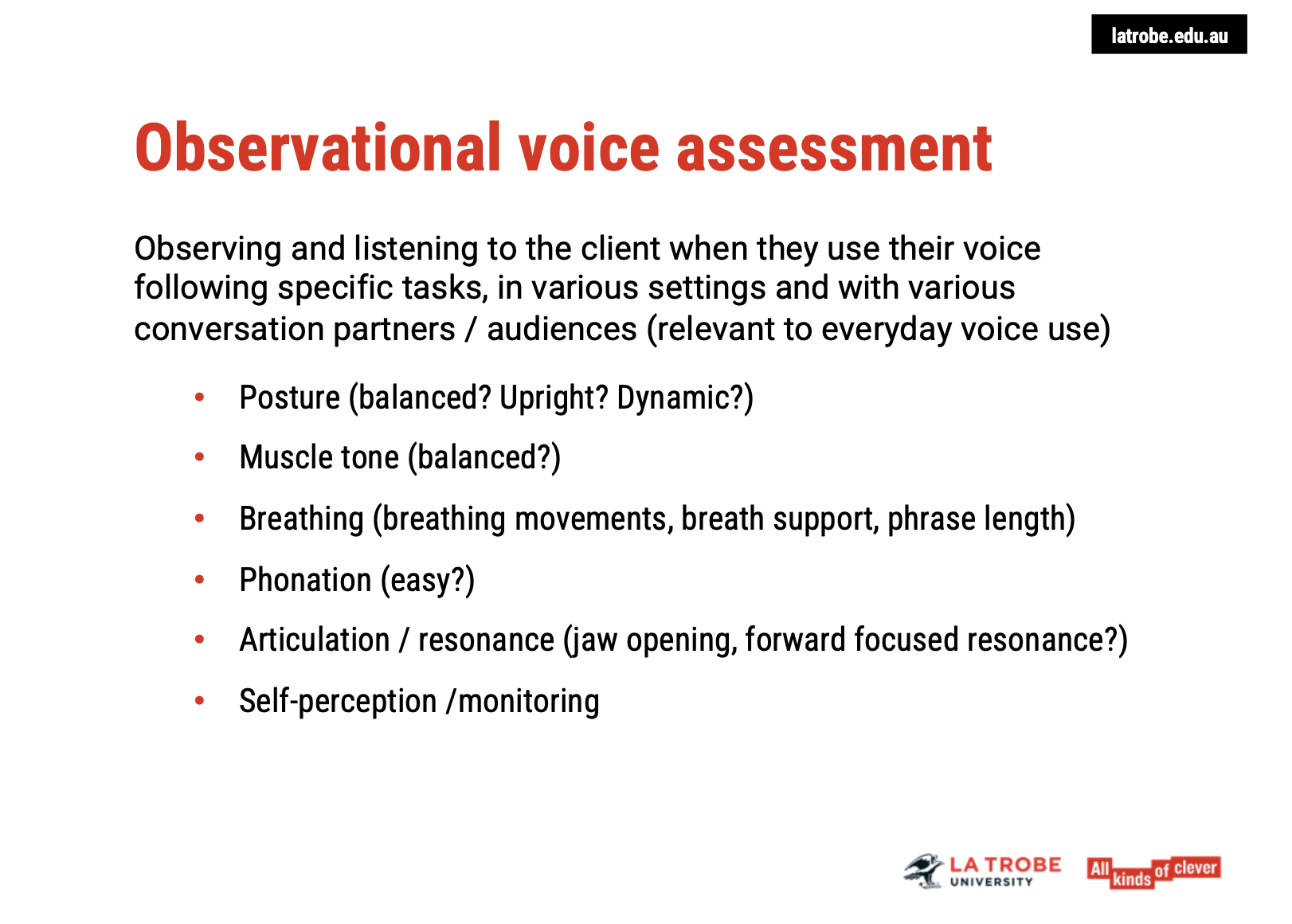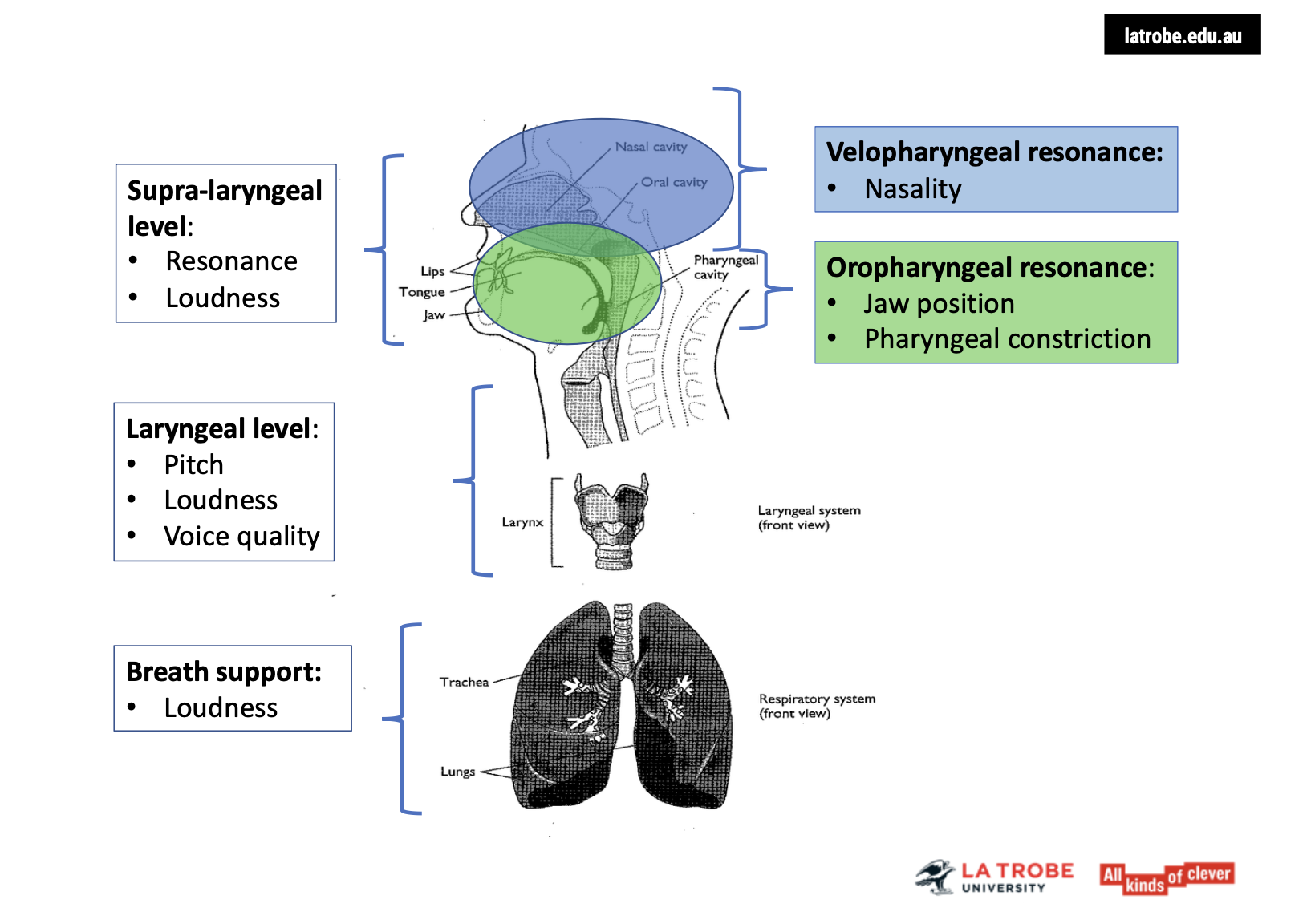Observational and auditory-perceptual voice assessment
1/3
There's no tags or description
Looks like no tags are added yet.
Name | Mastery | Learn | Test | Matching | Spaced |
|---|
No study sessions yet.
4 Terms
Observational Voice Assessment
1. Purpose of Observational Assessment 🧐
Goal: To observe and listen to the client during real-life voice use in various settings, with different conversation partners, and in line with their everyday vocal demands.
Initial Assessment: During the first session, a baseline recording is made in the clinic room. This helps to evaluate the voice in a controlled setting before moving to real-world contexts.
Importance for Professional Voice Users: For clients like teachers, performers, or auctioneers, it is vital to assess their voice in natural environments where they need to perform vocally.
2. Methods of Assessment 🎥📞
In-Vivo Observations:
Home or Work Environment: Visiting the client’s workplace, such as during teaching or a rehearsal, provides insight into how they use their voice in specific contexts.
Recording by Client: Alternatively, clients can record themselves in real-life situations. Ideally, video recordings provide additional data on posture and muscle tone, but audio recordings are also useful for capturing voice characteristics.
3. Key Observational Focus Areas 🧠
Posture & Muscular Tension 💪
Voice and Posture: Pay attention to how posture changes when the client is sitting versus standing. Look for whether their posture is balanced, upright, and dynamic.
Tension Areas: Look for excessive muscle tension, which is commonly found in the shoulders, neck, back, and jaw.
Client’s Self-Perception: Ask the client about tension and discomfort, and palpate muscles (if comfortable for the client) to identify physical stress areas.
Breathing and Breath Support 🌬
Breathing Patterns: Observe how the client breathes with and without voice. Note movements in the belly, chest, or shoulders.
Breath Support: The ideal breath support comes from the diaphragm. Assess whether the client can sustain their voice production without running out of breath.
Phrase Length: Check the client’s ability to produce voice within their comfort zone. If they exceed the optimal phrase length, they may run out of air, requiring deep breaths to compensate.
4. Vocal Characteristics 🎙
Voice Ease & Effort 💬
Voice Ease: A primary goal is for the voice to be produced with ease. Listen for whether it’s effortful or strained.
Client Feedback: Ask the client if they ever feel their voice is effortful and which situations exacerbate this. This will help identify areas for intervention.
Articulation and Resonance 🔊
Vocal Tract Functioning: Observe how the jaw moves during speech—does it open widely, or is the client speaking through their teeth?
Resonance: Focus on how sound resonates in the vocal tract. Is there a forward resonance focus, and how does this affect clarity and voice quality?
5. Client’s Self-Awareness 🧠
Self-Perception: Continuously check in with the client about how they perceive their voice and body alignment. Compare their self-perceptions with your observations.
Monitoring and Change: It’s essential for the client to be able to monitor their posture, muscle tone, breathing, and phonation. This skill is crucial for making lasting changes in voice production.
Conclusion 🎤
Observational voice assessment provides valuable real-world insights into a client’s vocal habits and issues.
By focusing on posture, breathing, muscle tone, and resonance, clinicians can identify specific areas for improvement.
Regular check-ins with the client ensure that both the clinician and client are aligned in their perceptions and expectations, allowing for effective treatment and intervention.

Auditory Perceptual Evaluation of Voice
Listening and Interpretation: The evaluation goes beyond simply hearing the voice. It's about interpreting and evaluating the voice in the context of established speech pathology standards.
Clinician’s Role: As a speech pathologist, you assess the voice by listening to it and interpreting its various components in relation to norms for healthy voice function.
2. Components of Voice Evaluation 🎙
Pitch: Evaluating the frequency of the voice—whether it’s too high, too low, or in an appropriate range.
Loudness: Assessing whether the voice is too soft, too loud, or at a functional level for communication needs.
Voice Quality: This includes the texture, tension, and resonance of the voice. Variations might suggest functional or structural issues.
3. Comparison to Standards 📊
Norms vs. Dysfunctional Voices: The clinician compares the voice to established standards—normal versus abnormal or atypical voice qualities.
Functional vs. Dysfunctional Voices: A voice is deemed functional if it fits within what is typically expected for communication. If the voice deviates significantly, it is considered dysfunctional, prompting further investigation into underlying causes.
4. Terminology Considerations 🧠
Cultural Sensitivity: The terms "normal" and "abnormal" can be seen as harsh or problematic. It’s important to use culturally responsive language that respects the individuality of the client.
Person-Centered Approach: Avoid defining the voice as simply "normal" or "disordered." Explain to the client that these terms are used to help identify whether there is a functional problem that might need attention.
5. Client’s Voice Perception 💬
Client's Perspective: If the client is not concerned about their voice and feels no need for intervention, that perspective must be respected.
Empowering the Client: As long as the clinician identifies no significant issue with the voice, there’s no need to intervene. Respecting the client’s autonomy in their voice care is key, even if clinical standards might suggest a concern.
6. Conclusion ✔
Objective: The auditory perceptual evaluation provides an important foundation for understanding the voice from a clinical perspective, identifying potential functional issues.
Collaboration: Throughout the process, it’s crucial to involve the client in the decision-making process and respect their personal voice preferences. This ensures a holistic and person-centered approach to voice care.

Auditory Perceptual Evaluation: Key Components of Voice Production
1. Breath Support and Vocal Fold Closure 🌬
Breath Support: A strong breath support is essential for a wide loudness range, enabling the voice to fluctuate from soft to loud.
Impact on Loudness: If a client’s voice lacks sufficient loudness, it could indicate issues with their breathing practices or the closure of their vocal folds.
Vocal Fold Closure: If the vocal folds do not close fully, air escapes, leading to inefficient vibration and poor voice production.
2. Laryngeal Level 🗣
Pitch Control: The laryngeal muscles regulate the pitch of the voice, allowing for flexibility and changes in tone. The internal laryngeal muscles are responsible for lowering or raising the pitch.
Voice Quality: Voice quality is influenced by the function of the vocal folds, and common issues include:
Breathiness: Caused by incomplete closure of the vocal folds, leading to air escaping.
Strained Voice: Occurs when the vocal folds are too tightly pressed together, causing excessive effort in the voice.
Roughness: Results from irregular vocal fold vibration, leading to an uneven voice.
3. Vocal Tract Function 🎶
Vocal Tract Resonance: The vocal tract amplifies the voice, shaping its resonance and timbre, much like a megaphone.
Velopharyngeal and Oropharyngeal Resonance:
Oropharyngeal Resonance: Involves the shaping of the oral and pharyngeal cavities, where the jaw position plays a crucial role. Speaking through the teeth, for example, affects the quality of the voice.
Pharyngeal Constriction: This refers to pressure at the back of the pharynx, narrowing the vocal tract, which can alter the voice’s quality.
4. Nasality in Voice Production 🌬
Velopharyngeal Function: The velum (soft palate) plays a critical role in determining whether sounds are oral or nasal.
If the velopharyngeal port is open, nasal sounds are produced.
Nasality Variations:
Hypernasality: Excessive nasal resonance.
Hyponasality: Insufficient nasal resonance.
Nasality in Observational Voice Analysis: Variations in nasal cavity involvement contribute to the overall voice quality and should be considered during auditory perceptual evaluations.
5. Conclusion 🧠
Holistic Voice Assessment: In auditory perceptual evaluations, assessing the breath support, vocal fold closure, laryngeal functioning, and resonance shaping all provide key insights into the health and functionality of the voice.
Comprehensive Approach: Combining the anatomical understanding of voice production with auditory analysis allows clinicians to evaluate and identify potential areas of concern, offering tailored interventions for clients.

xx
xx